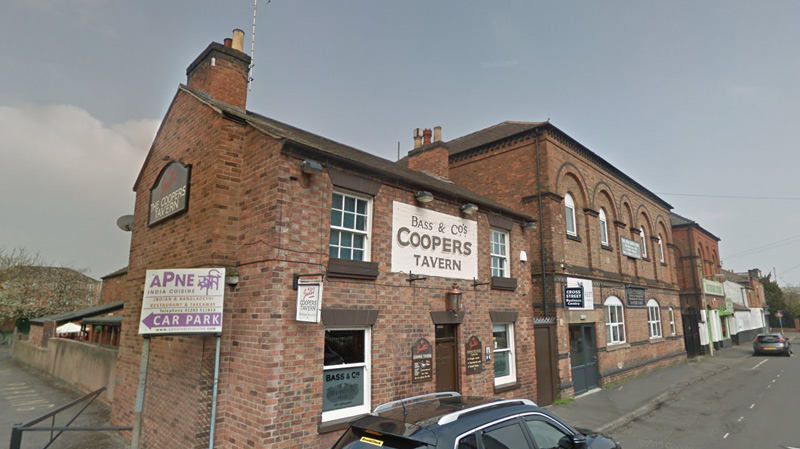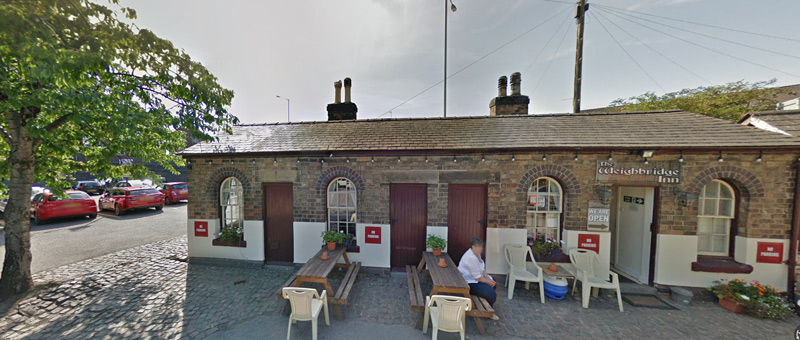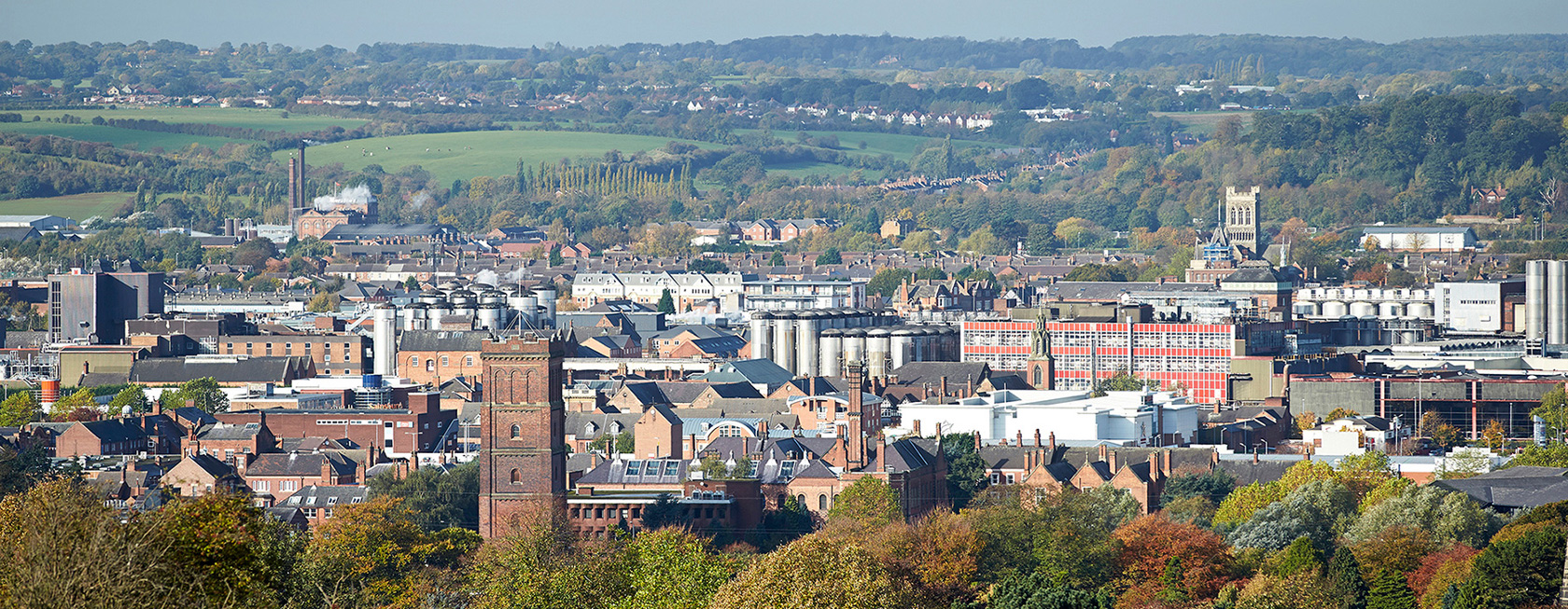Burton-on-Trent (UK), November 2019
Seminar with Doshu Yoshigasaki
“I’ve been waiting for the bus since 2001 and it hasn’t come”.
 The flight from Vienna arrived punctually Friday afternoon into London Heathrow. From there I travelled by car to the Midlands with family. Then, as predicted, the wild and mystical travel lottery that is rail travel in the UK could begin in earnest. The train I’d planned on taking from the small town of Market Harborough to Burton, changing at Leicester and Derby, was cancelled. My enquiry at the ticket office as to my options was met in a relaxed, nonchalant tone of “I think Burton is still flooded and no trains are running”. Not convinced and having already followed proceedings closely on the website from the car, I waited for him to check the system and then confirm that it may be possible after all.
The flight from Vienna arrived punctually Friday afternoon into London Heathrow. From there I travelled by car to the Midlands with family. Then, as predicted, the wild and mystical travel lottery that is rail travel in the UK could begin in earnest. The train I’d planned on taking from the small town of Market Harborough to Burton, changing at Leicester and Derby, was cancelled. My enquiry at the ticket office as to my options was met in a relaxed, nonchalant tone of “I think Burton is still flooded and no trains are running”. Not convinced and having already followed proceedings closely on the website from the car, I waited for him to check the system and then confirm that it may be possible after all.
With (only) one hour delay, in two packed trains of mostly “keep calm” styled Britishness, a dark and gloriously dingy Burton, immediately identifiable from the station surrounded as it still is by its Victorian and contemporary beer brewing topography, had been reached. I say ‘only’ as, not only would I make the training on time as scheduled, but the favourable delay (as opposed to potential Armageddon) presented the opportunity, most properly, to imbibe a local institution and whet the senses with a swift half in the delightful Coopers Tavern that just happened to be on the way. One of the weirdest and most interesting pubs I’ve ever seen, and visited later that evening, greets guests of the central Travelodge hotel in which a few of us stayed. A historic elongated single storey building, it is now indiscriminately located in the middle of the hotel car park! But that’s another story.
On the meaning of Do (道) or, “I’ve been waiting for the bus since 2001 and it hasn’t come”
 Despite the warnings and calls for action, starting with the Club of Rome (Limits of Growth, 1972), and the downward turn in the global economy in recent decades, no new international arrangement has been made to determine a new direction. It showed that “…it is impossible for everyone to agree on the same thing.” Older people living today have lived through these major changes and thus have the possibility to understand how the world has changed. Yet, generally, people 40 or 50 years ago could see improvements and a better life on the horizon. What about young people today? “What should we do when the future looks negative, when life is going down?”…
Despite the warnings and calls for action, starting with the Club of Rome (Limits of Growth, 1972), and the downward turn in the global economy in recent decades, no new international arrangement has been made to determine a new direction. It showed that “…it is impossible for everyone to agree on the same thing.” Older people living today have lived through these major changes and thus have the possibility to understand how the world has changed. Yet, generally, people 40 or 50 years ago could see improvements and a better life on the horizon. What about young people today? “What should we do when the future looks negative, when life is going down?”…
One value of martial arts is trying to understand life without sentiment, emotions and psychology. For example, when someone acts in an aggressive manner it is only important what you do, not what you ‘feel’. This is the justification for the emphasis of meaning on what you do (act), and not what you feel or necessarily think. It brings life perception into being: Not in past time, but the next second. That is the basis. In order words, the question of creating future life and this world, it is not so much useful to compare the future path to the past, but rather perceive and act from the position of what can be done now (in the smallest perceptible time frame or span).
This raises the question: what is positive and negative? Positive is (potentially) when one’s mind is in the future and if one’s mind is in the past it is (potentially) negative. Doshu’s definition avoids the teleological trap (that a “positive mind” necessarily creates certain positive outcomes by design) through considering “potential” outcomes. I will forego a lengthy discussion on philosophical issues in favour of suggesting that readers reflect on the meaning and consequence of this concept for themselves.
Do your best
 Do your best to create a better future. Not only people in general, but also Aikido masters have difficulty to grasp this idea. For example, if you think that something is positive when it allows or helps you to feel good. It is not reducible to feelings and emotions. Making the future better is clearly a social question predicated on relationships and not a simple matter of “doing what you like”. This may sound similar to a utilitarian philosophy, but it is quite different. Sensei has remarked that “Aikido is like a joke”. A joke can be many things and although it may have a use, it is not useful in the sense of having a clear function or purpose. If you only learn techniques, whether in science, medicine, architecture, or aikido, then usually you want to apply those techniques. For “point mathematics” based pursuits based on hard materials this has meaning and value. For example, in building a safe bridge in an appropriate location. But still it can’t tell us if it is good or positive for the whole society (is it a good allocation of funds? Does it benefit the people and wildlife living close to the bridge? Etc.) Clearly in the context of the arts and daily life this is an important question. On the other hand, “form mathematics” is the study of life and relationships. Aikido and arts fall into this category and should seek to express and develop the human and social condition.
Do your best to create a better future. Not only people in general, but also Aikido masters have difficulty to grasp this idea. For example, if you think that something is positive when it allows or helps you to feel good. It is not reducible to feelings and emotions. Making the future better is clearly a social question predicated on relationships and not a simple matter of “doing what you like”. This may sound similar to a utilitarian philosophy, but it is quite different. Sensei has remarked that “Aikido is like a joke”. A joke can be many things and although it may have a use, it is not useful in the sense of having a clear function or purpose. If you only learn techniques, whether in science, medicine, architecture, or aikido, then usually you want to apply those techniques. For “point mathematics” based pursuits based on hard materials this has meaning and value. For example, in building a safe bridge in an appropriate location. But still it can’t tell us if it is good or positive for the whole society (is it a good allocation of funds? Does it benefit the people and wildlife living close to the bridge? Etc.) Clearly in the context of the arts and daily life this is an important question. On the other hand, “form mathematics” is the study of life and relationships. Aikido and arts fall into this category and should seek to express and develop the human and social condition.
Good ol’ times?
If the future looks bright, you can compare past with future because it is improving. But if the future looks bleaker than the past then clearly a comparison is unpleasant. During such times, it is all the more pertinent to ask what can be done. Since around the year 2000 the world has been getting poorer. Most people are either less well off, or remained poor. Doshu expressed that “the world is getting old”. Just like humans, it can become old and weak. The baby boomer generation is a special generation. They lived through remarkable change. Economic miracles, etc. Now young people today don’t have that prospect. Their future looks bleaker and poorer.The only thing left is for each person to find their own way = Do. This is the value and meaning today of (Aikido) practice. Do is defined as a way, lived step-by-step. In other words, it is a path which one walks. In this way, it is always possible to alter course. The way of investments, train and air travel on the other hand doesn’t allow this: Wait, invest (time, money), travel straight ahead in time. It is difficult to change course once the plane or train has departed. Therefore, there is a clear distinction between Do as a continual process of leading one’s life and the industry and technology of the modern petrol and energy based economy.
In real or daily life Do can be many things. It can be jogging, for example, or anything which seeks to improve life in one’s environment. Aikido is just one Do, however, we can suppose that it is an advanced practice. Do is not uniquely Japanese. It simply has a clear association through a cultural and artistic tradition (Chado, Ikebana, calligraphy, pottery, etc). In any case, it seems that the concept encompasses both the individual (for its own sake) and as part a social relationship (for the sake of improving social life.
Burton-on-Trent

A note on language
The Japanese language is not like Chinese at all. It is a different language group. The fact that the Japanese language adopted Chinese characters does not mean that it adopted the same meanings and expressions. For example: Do (道) is related to the Chinese word (Tao/Dao), but the real Japanese expression is Michi (みち). Michi means the continuation of something (in an unknown future). We should always consider the meaning of something and be able to understand or create new meaning. The forms of Kenkotaiso and Aikitaiso are registers of meaning for Aikido. One example: Ikkyo tenshin. What is the meaning of this exercise? Which hand is most important when changing direction, hanmi or gyaku hanmi? Consider the attack from behind and the meaning of gyaku hanmi.Forms and symmetry. One way of conceiving practice.
What is possible from which form? Consider groups of techniques based on the similar/same form of Uke. For example– Katatekosadori kokyunage tenshin (open hand) and irimi (close hand)
– Katatedori kokyunage I and II (lose hold), throw it away and make a movement upwards which also protects the face from a possible use of the arm or hand.
– Katatedori Shihonage (Shihonage – the elbow should not be higher than shoulder – don’t push up, but make the knees bend). All start from the same form of Uke. This can be explored much further.
Symmetry.
E.g. from koteoroshi to ikkyo/sankyo by turning in one direction or the other. There are many possibilities for working with symmetry. Turning (this way or that) is one way to imagine and practice.
Participants came from England and Wales and thanks to the initiative of Linda Gale, a few people also attended from other Aikido organisations.
The next UK seminar will be held in Burton again in April (17th-19th) 2020.
Ryan Jepson, 13.12.19, Vienna
(The author attended Friday evening and Saturday only)